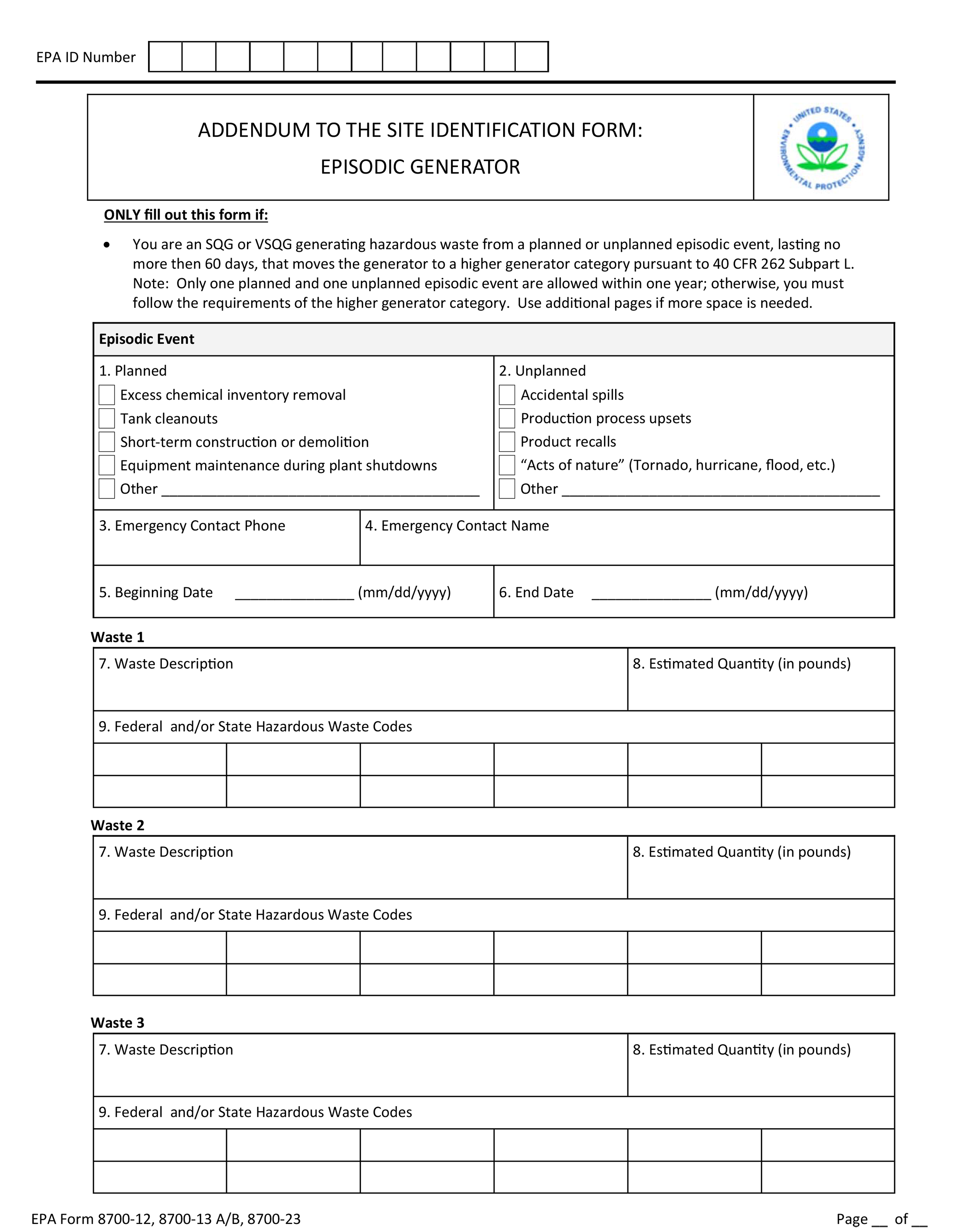Episodic Generator Notification
As part of the 2016 Hazardous Waste Generator Improvements Final Rule, the concept of “episodic generation” was established. This gives hazardous waste generators that are Very Small Quantity Generators (VSQG) or Small Quantity Generators (SQG) a mechanism to temporarily exceeding normal generator category limits yet maintain their existing generator category, provided the generator complies with the any applicable conditions identified at 40 CFR 262.232 (a) and (b). In other words, a hazardous waste episodic generator is either a VSQG or an SQG who generates a quantity of hazardous waste in a calendar month sufficient to cause the facility to move into a more stringent generator category — a VSQG to either an SQG or an LQG or an SQG to an LQG. This can occur because of a planned or unplanned event at a generator site. Examples of planned episodic events include, but are not limited to, tank cleanouts, short-term site remediation, equipment maintenance during plant shutdowns, and periodic removal of excess chemical inventories. Examples of unplanned episodic events include, but again are not limited to, production process upsets, product recalls, accidental spills, or natural disasters such as tornado, hurricane, or flood. Episodic generator notification must be submitted to EPA during specific timeframes for an event to be in compliance with the conditions of the applicable provisions. For any planned episodic event notification must be made more than 30 days before the event takes place. In the case of an unplanned event, notification must take place within 72 hours of the event occurring. Both planned and unplanned episodic events must be completed with all waste shipped off-site within 60 days of the start of the event. Generators wishing to use the episodic generator provisions must use EPA form 8700 (or the applicable state equivalent) to notify EPA or State of the events.
Part 1. General Report Components:
- Notification must submit a Site Identification Form along with the applicable Episodic Generator Addendum.
- All boxes that apply, should be completed with an “X”. Not a checkmark or by filling in of the entire box.
- Include the Site EPA Identification Number at the top of each page, including each form, addendum, and additional page.
- Page numbering should be completed at the end of process, to ensure accurate numbering. Page numbers should be consecutive for all pages, not starting over at the addendum or additional pages.
Figure 1 – Site identification form
Item 1. Indicate the reason for submittal. For episodic generation the reason is the first option (“Obtaining or updating an EPA ID number for on-going regulated activities (items 10 – 17) that will continue for a period of time”), as indicated in the example.
Item 2. Provide the EPA Identification Number for the site that will have the episodic waste event. Reminder to include the same EPA Identification Number at the top of all pages being submitted.
Items 3 and 4. Provide the legal name of your site and a complete location address. The address, in this section, must be a physical address. For sites that do not have a physical address, latitude and longitude coordinates may be used and an X placed in the following box, indicating “Use Lat/Long as Primary Address.”
Item 5. Provide the mailing address for the site, that can be different than the site address and can be a P.O. Box. When it is the same as the site location, that can instead be indicated by using the checkbox.
Item 6. Indicate only one land type, indicating the best option. If more than one type would be appropriate, indicate the best option here and use the Item 18 comment box to provide further explanation.
Item 7. Provide at least one NAICS Code for the site generating the waste. The first box indicated with “Primary” is a mandatory field. Any additional NAICS Codes can be included but are not required.
Reminder: Page numbering should be completed at the end of process, to ensure accurate numbering that includes all application pages.
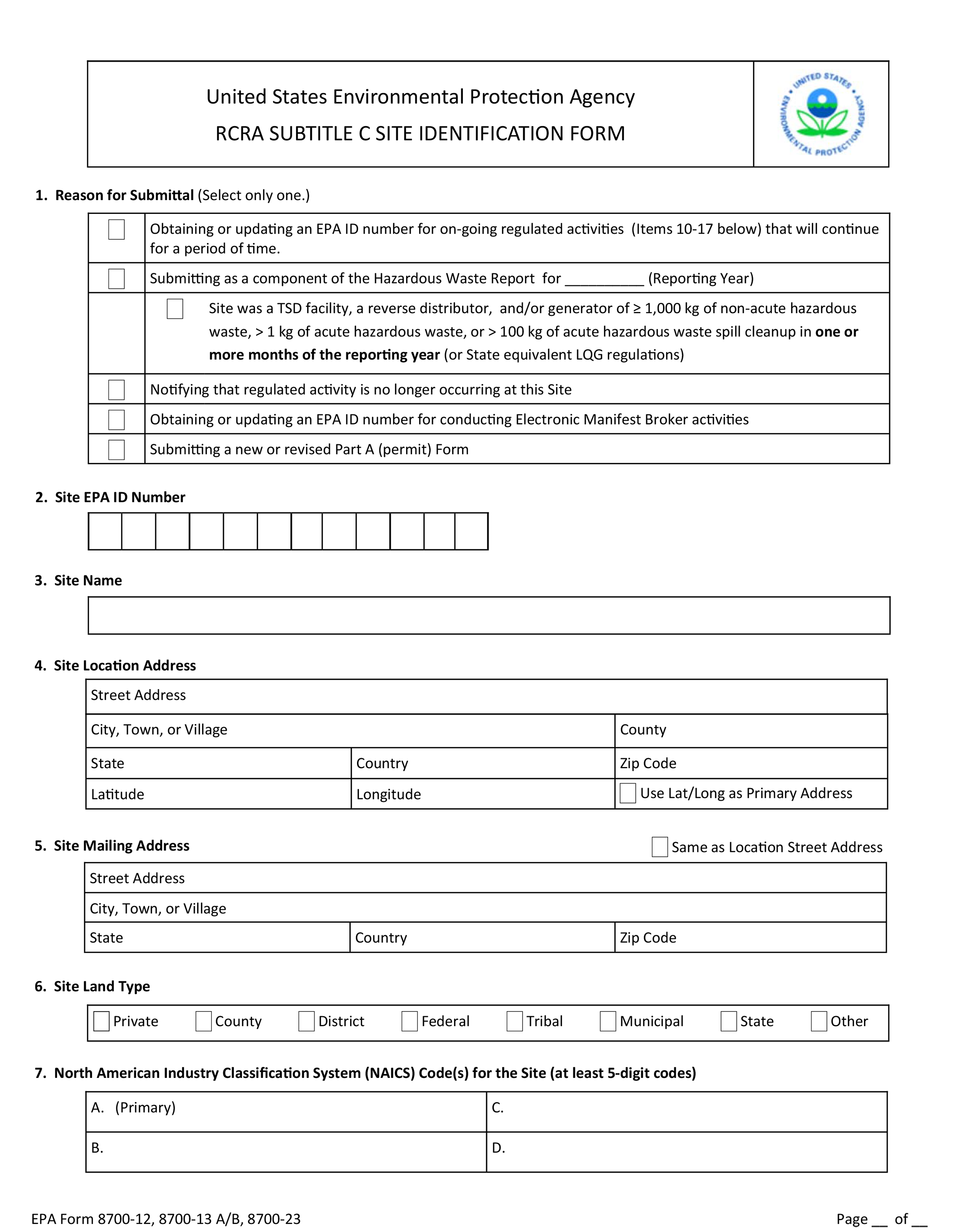
Figure 2 – Site identification form
Item 8. Include information for the individual who should be contacted regarding the information submitted in the Site ID Form. If there are other individuals who may be contacted about this submission, make that indication in the Item 18 comment box. Address information can be simplified by using the “Same as location address” checkbox.
Item 9A. When indicating the legal owner, this may be an individual, company, or business name. The inclusion of date when ownership began is optional information. Only one owner type may be selected, select the one that best describe the owner even in more than one could be used. Address information can be simplified by using the “Same as location address” checkbox.
Item 9B. When indicating the legal operator, this may be an individual, company, or business name. However, different than owner, the operator is usually a company or business name, but may be an individual. The inclusion of date when operation began is optional information. Only one operator type may be selected, select the one that best describe the operator even in more than one could be used. Address information can be simplified by using the “Same as location address” checkbox.
Reminder: Page numbering should be completed at the end of process, to ensure accurate numbering that includes all application pages.
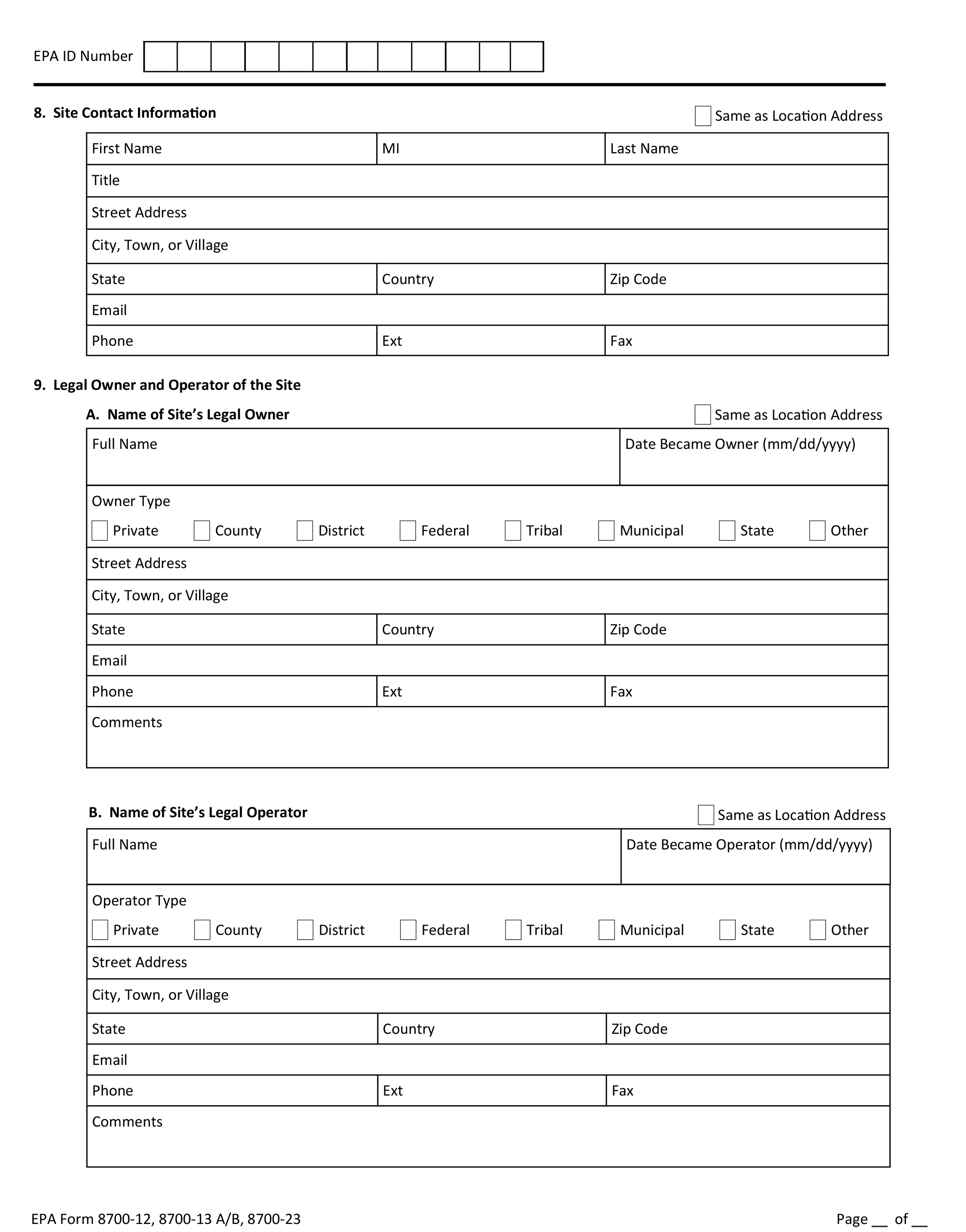
Figure 3 – Site identification form
Item 10A. This section of the form can be very confusing when making episodic generator notification. Indicate ‘Y’ for part 1, Generator of Hazardous Waste. Then mark and ‘X’ in the box (a, b, or c) indicating the generator category. This should be the generator size that the site is normally, not the size that it will be “bumping up” to during the episodic event.
For episodic generation, DO NOT mark ‘Y’ for section 2, Short-term Generator.
Item 10B. Here list the waste codes of all Federal hazardous wastes handled at your site. The codes should be listed in the order they are presented in the regulations. Even if there will only be one or two codes used with the waste generated in the episodic event, include all codes for wastes at the site. Because of this, if your site generates a large number of wastes this item can be slightly cumbersome.
Item 10C. If you manage State-regulated hazardous wastes that have State waste codes, enter those in this section.
If you handle more hazardous wastes than will fit under Item 10.B or 10.C, continue listing the codes in the Item 18 comment box or on an extra sheet. If an additional sheet of paper is used, remember to include your EPA Identification Number on the top of the page(s).
Reminder: Page numbering should be completed at the end of process, to ensure accurate numbering that includes all application pages.

Figure 4 – Site identification form
Item 11A-D. Place an “X” in the “Y” or “N” box as appropriate for all additional current regulated waste activities at this site. This should be completed for activities occurring as of the date the form is certified.
Reminder: Page numbering should be completed at the end of process, to ensure accurate numbering that includes all application pages.
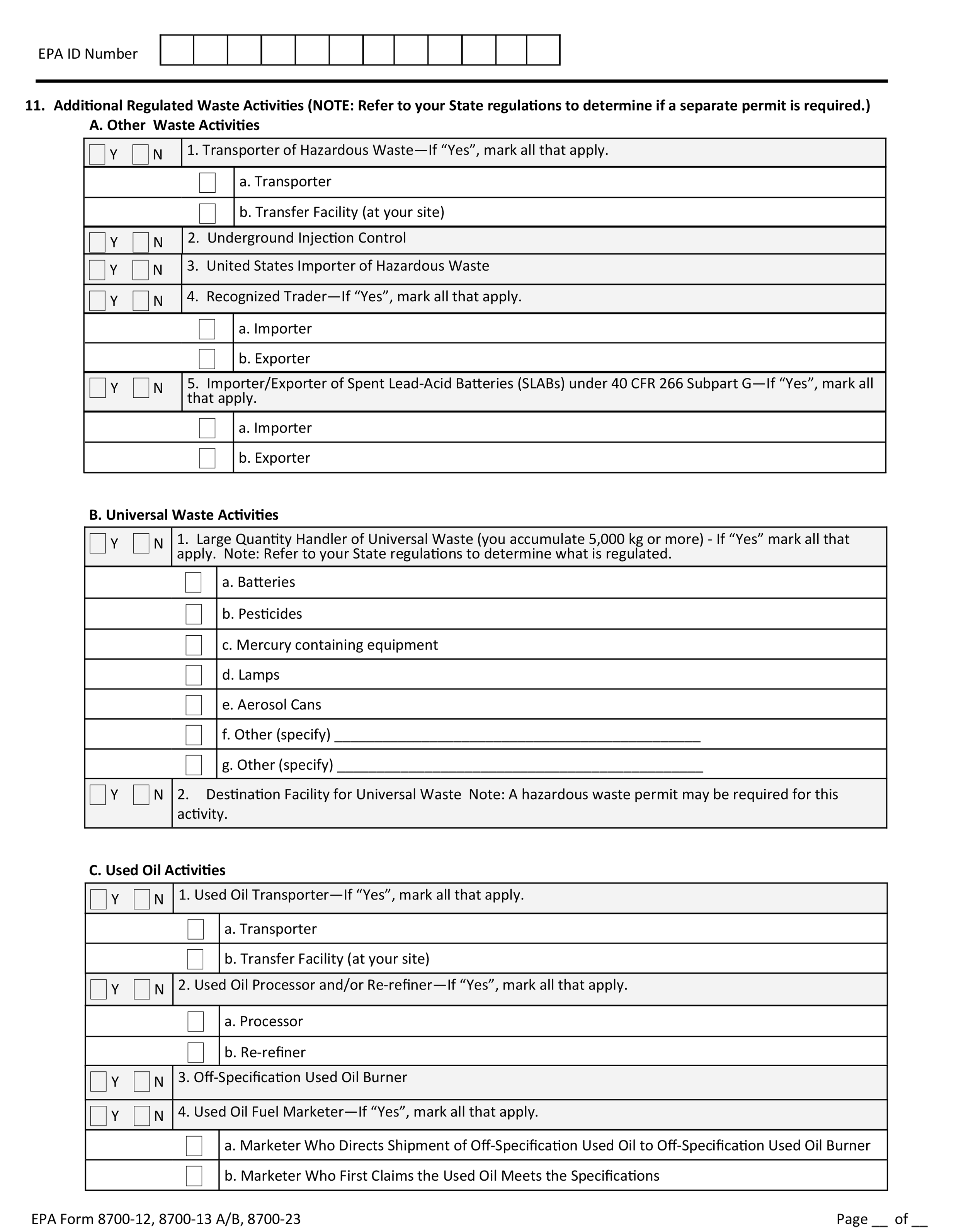
Figure 5 – Site identification form
Item 12. Academic entities with laboratories, that meet specific eligibility requirements, can follow an optional alternative set of requirements waste generation. If this applies to your site, indicate that here.
Item 13. This section is likely the most important for episodic generation notification. In this section, mark the ‘Y’ box with an X, as indicated in the example.
Item 14. LQGs can receive and consolidate hazardous wastes from VSQGs if the VSQGs are under the control of the same “person” as defined in 40 CFR 260.10. This element likely won’t apply when making notification for episodic generation. If it does, there are actions, beyond those listed in this guide, that will need to be completed.
Item 15. This section is used to notify EPA of a number of different closure scenarios for LQGs. This element likely won’t apply when making notification for episodic generation.
Reminder: Page numbering should be completed at the end of process, to ensure accurate numbering that includes all application pages.
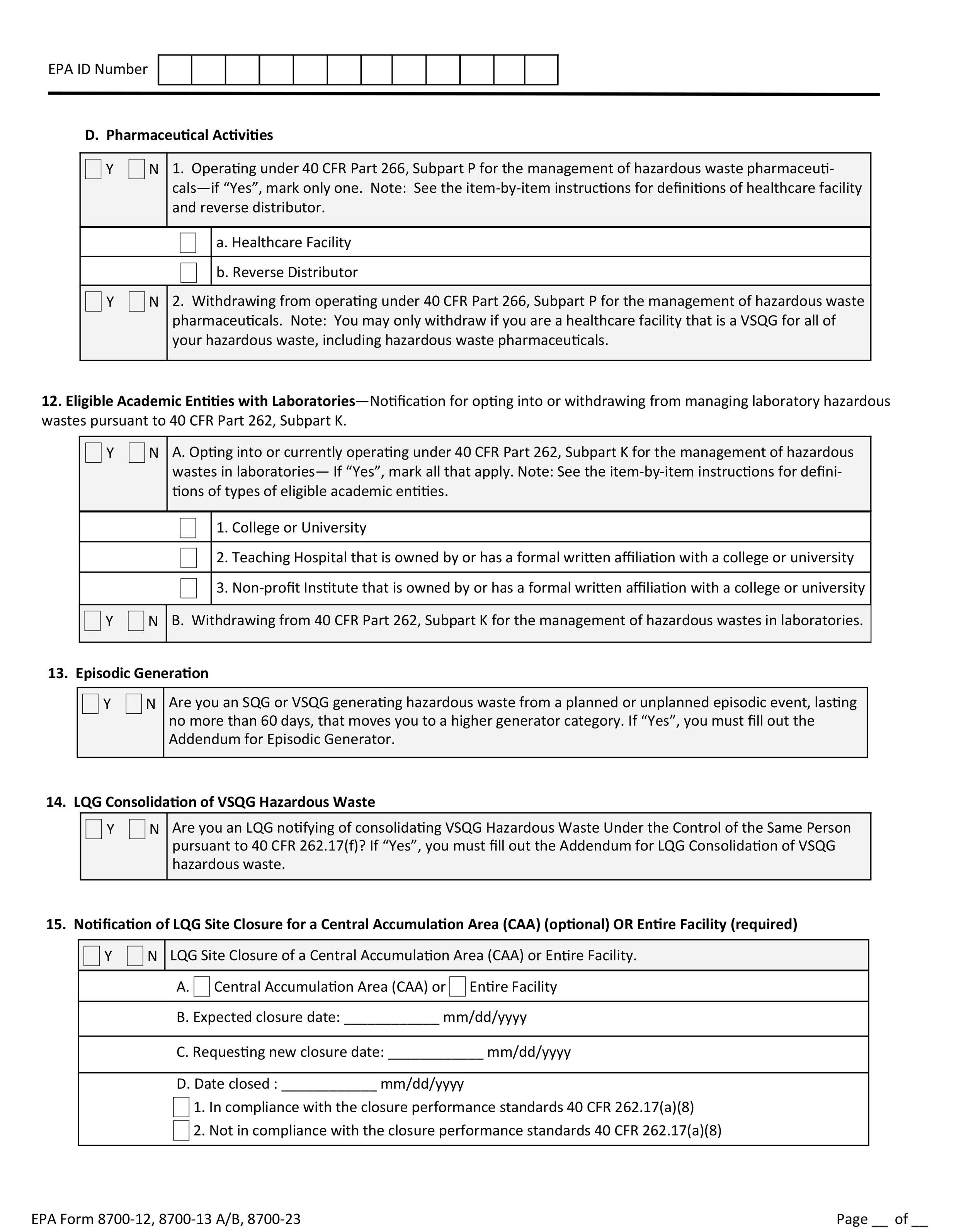
Figure 6 – Site identification form
Item 16. Complete this part of the form if you are notifying EPA that you will begin managing, are still managing, or will stop managing hazardous secondary material. This section likely won’t apply when making notification for episodic generation.
Item 17. Use this section if you are a person that elects to use the electronic manifest system to obtain, complete and transmit an electronic manifest format supplied by the EPA electronic manifest system under a contractual relationship with a hazardous waste generator.
Item 18. This area should be used to provide additional information as needed for Items 1 through 17 and 1 through 9 on the addendum. For all inputs into this box, include the item number that it is associated with. Alternatively, additional sheets of paper can be used to provide additional information. Remember to include your EPA Identification Number on the top of each page.
Item 19. The final element on the signature page is the certification. This must be signed and dated by the owner(s)/ operator(s) of either the generator or TSDF, or an authorized representative(s) of the site.
Reminder: Page numbering should be completed at the end of process, to ensure accurate numbering that includes all application pages.
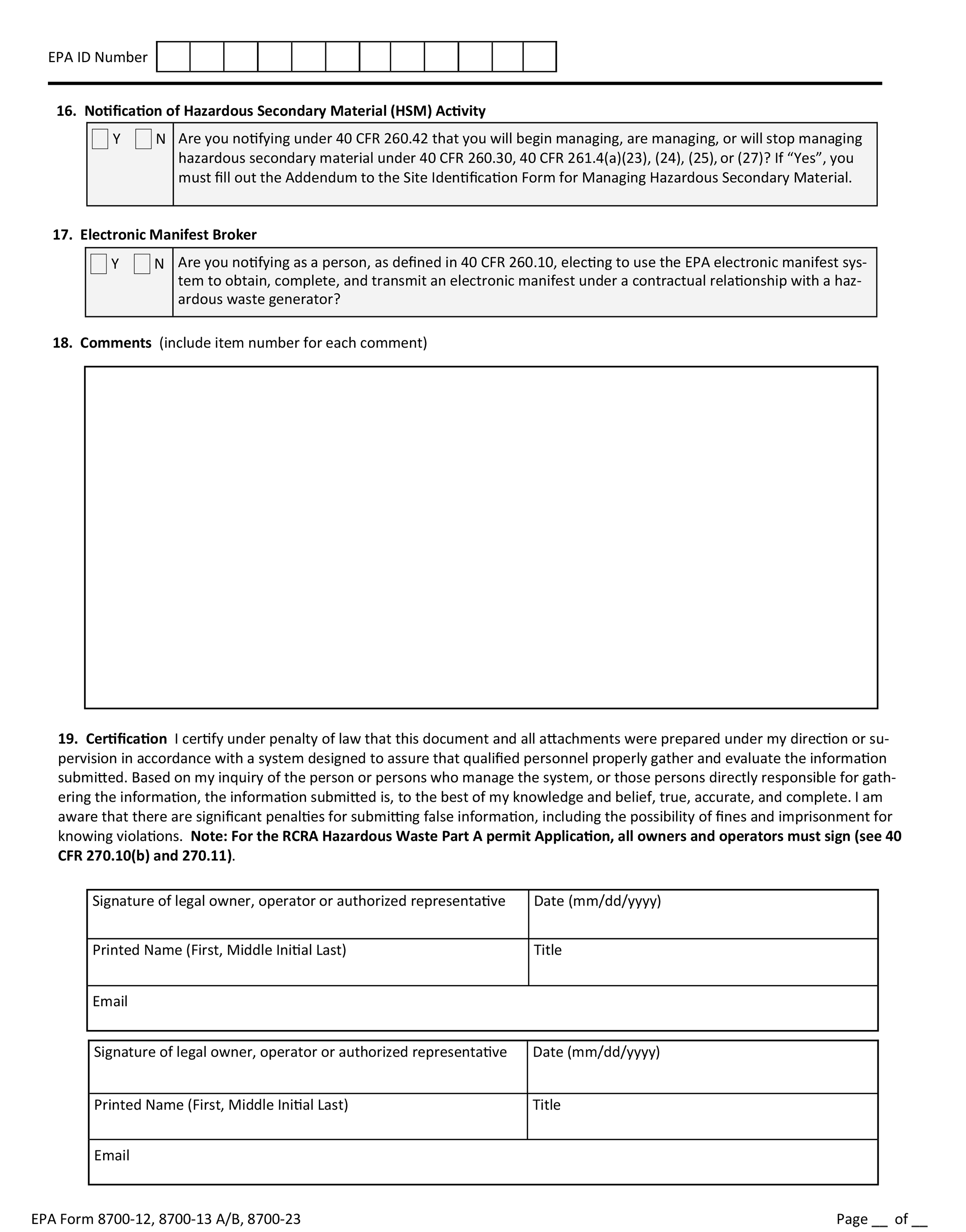
Figure 7 – Episodic generation addendum
Item 1 and 2. Indicate in section 1 if the event planned and in section 2 if an unplanned event. For either type of event, indicate the reason for the planned or unplanned event. If none of the reasons listed apply, mark “Other” and describe the event on the line provided or in the item 18 comment box (on the site identification form).
Item 3 and 4. Provide an emergency contact phone number and name for the person who should be contacted regarding the information relating to this episodic event.
Item 5 and 6. Provide the estimated start date and end date of the event. The event must be complete within sixty days of the start date, therefore the date entered as end date should meet that time frame.
Item 7, 8 and 9. For each waste stream produced from the episodic event, provide a description of the waste (item 7), the quantity that you estimate will be generated (item 8), and the applicable hazardous waste codes, both federal and state (item 9). The form provides space for three wastes to be identified. It additional wastes will be created, use additional sheets of paper. If an additional sheet of paper is used, remember to include your EPA Identification Number on the top of the page(s).
Reminder: Page numbering should be completed at the end of process, to ensure accurate numbering that includes all application pages.
